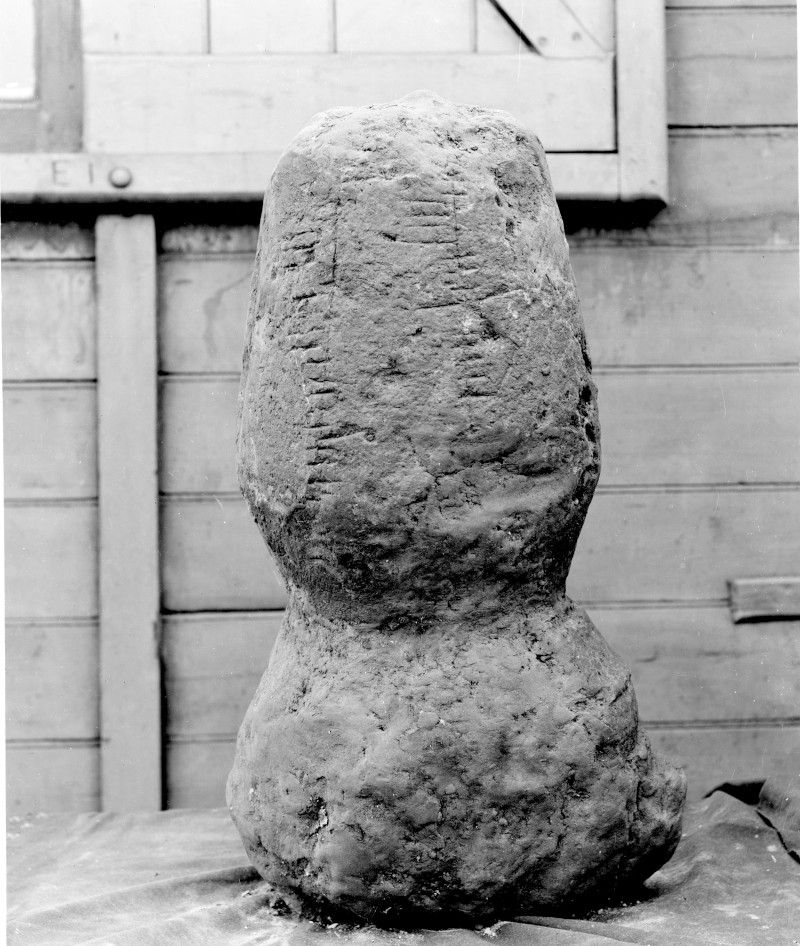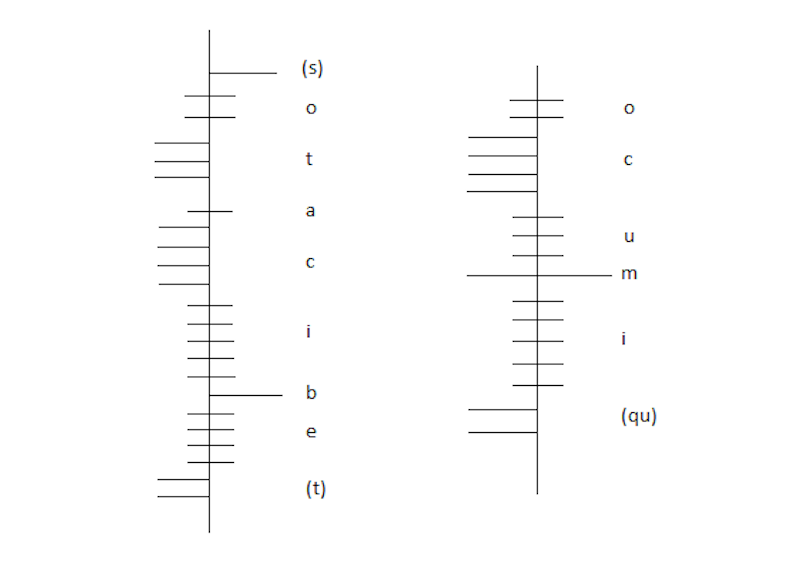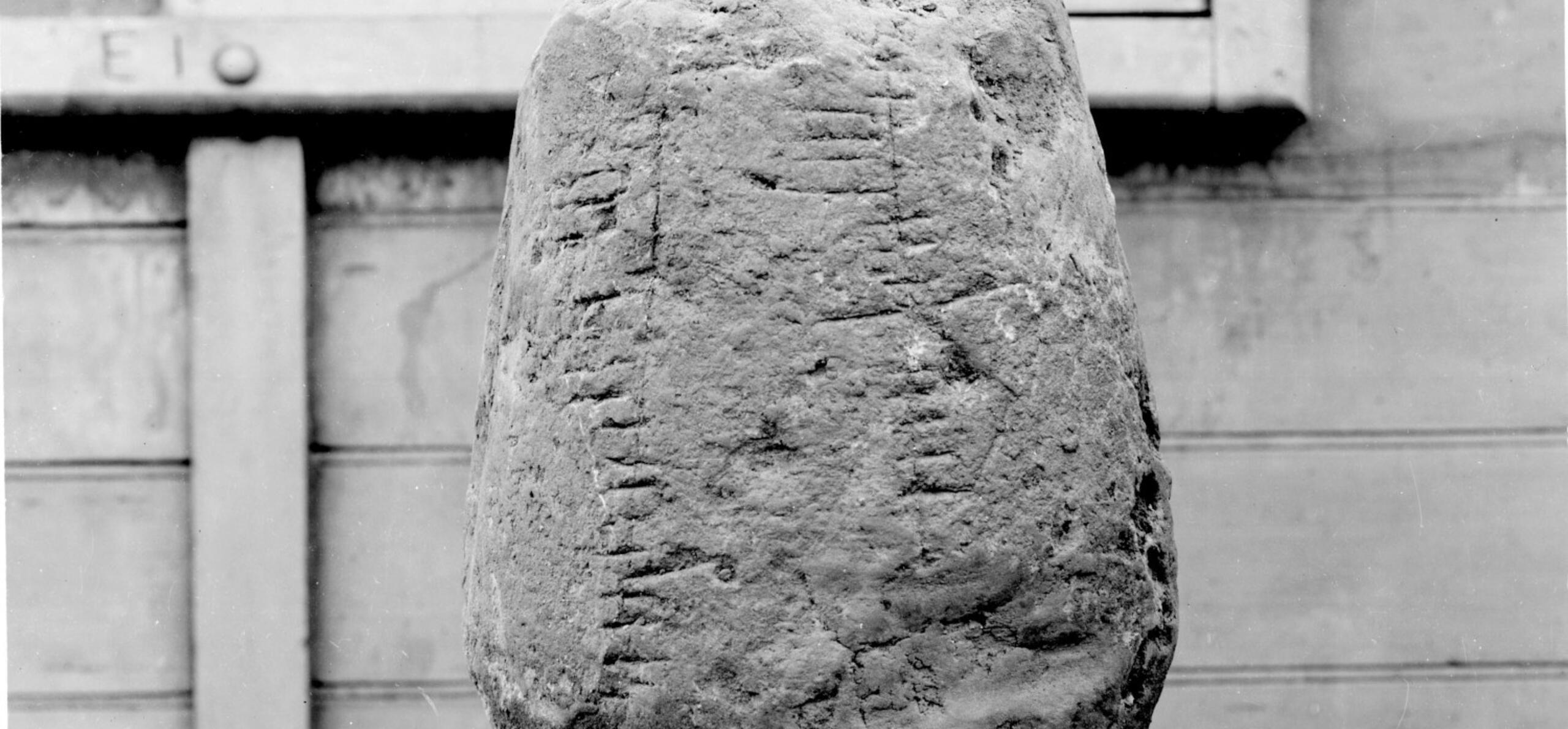In 1893, excavators at the Roman town of Silchester (Calleva Atrebatum), Hampshire, discovered a small, battered column, about 60cm tall, top-down in a well that had been dug through the foundations of a ruined house. Only when they cleaned it did they realise what they had found. Washing the stone revealed markings which were identified as an ‘inscription written in Ogham characters’. It remains the most easterly find of an Ogham stone to date.
In this blog, learn about the Ogham stone found at Silchester. Who made it, and what for? And what does it tell us about life in the Roman town after the Romans left?

Ogham stone (REDMG : 1995.1.24) photographed soon after discovery in 1893. (REDMG : 1928.244.635)
What are Ogham stones?
Ogham stones are monumental stones, often thought to be gravestones or memorials, although many appear to indicate land ownership. They can be of any size and feature inscriptions in the early medieval alphabet of Ogham.
Reading Ogham
Ogham is what's known as a Celtic tree alphabet. In this language, the words are read from bottom to top, whilst letters are formed by groups of horizontal lines both either side and across a vertical axis.
The inscription on the stone found at Silchester features two lines of words. It is damaged and missing letters at the beginning and end of the phrase. Translated, it reads ‘TEBICATO[S] / [MAQ]I MUCO[I...]' which means ‘(the something) of Tebicatos, son of the tribe of (?)’. Remarkably, this means we have the name of a person who lived in the town in around the 5th century.

Ogham inscription on the stone from Silchester with translation.
Where did Ogham come from, and who used it?
The Ogham script was used in southern Ireland from the 4th to 7th centuries in a non-religious context. An inscription in Ogham denoted ties to land. Whilst Ogham stones are mainly found in Ireland, a few have been discovered on the Isle of Man, and in Wales, Devon and Cornwall. But the Silchester stone is the only one from any site east of the River Severn.
Who made the Silchester Ogham stone?
There is not much evidence of the end of Calleva Atrebatum, but this inscription reveals that life continued there beyond the Roman withdrawal from Britain. Insula IX, the area of the town in which the Ogham stone was found, was excavated thoroughly by Prof Michael Fulford and his team from the University of Reading between 1997 and 2014. This detailed investigation confirmed that the well in which the Ogham stone was found was contemporary to the backyard of a cottage occupied in the 5th century.
The stone was originally a baluster that would have formed part of a portico or verandah. It was carved from greensand rock quarried in the Weald of Surrey and had to be brought to the site by road. It is very worn and the capital is missing, so it could have been taken from the ruins of an earlier, grander house for re-use.
Was Tebicatos Irish? Was he a Christian pilgrim travelling to Rome? Maybe he decided to stay, and carved this dwarf column to mark his ownership of the cottage. No body was found, suggesting it was not a tombstone. Were there many Irish people in Calleva? There seems no reason to write in Ogham unless it could be widely understood.
The placement of the stone put the well out of use when the house was abandoned. It is one of the latest signs of occupation of the Silchester site to be found.
The afterlife of the Silchester Ogham stone
After its useful life ended in the well, the stone survived for 1500 years until its discovery by the excavators. But the rock it is made from is soft and friable, and after 40 years of study and display, it had started to crumble, threatening the inscription cut shallowly into it.
The best solution the curator of the day could think of was to stabilise the fragile surface with a kind of wax, which would soak into the rock and bind it. Unfortunately, this turned out not to be a good idea. The wax has discoloured over time, giving the stone a dark appearance very different from when it was found, and the wax-impregnated layer started to detach and flake off, leading to further consolidation efforts in the 1950s. In the past 20 years conservators have been consulted, but (unlike today) the processes used were not reversible and the wax cannot be removed without destroying the inscription.
Displaying or even handling the stone now risks further damage. However, we always hoped that better technology could come to the rescue, and this year an opportunity arrived! The quality of 3D imaging that is now possible means we were able to commission a digital model of the stone as a way of both preserving by record the original and allowing it to be seen and studied by anyone.
Take a look at the Ogham stone in full 3D on the Reading Museum Sketchfab account.
Find out more
Interested to learn more about Ogham? See these websites: transliterator (converting Latin script into Ogham) and foundations of Ogham. Or learn more about the Society of Antiquaries initial excavations as discovered by the University of Reading.
Prof Fulford’s book Silchester Revealed: The Iron Age and Roman Town of Calleva is a very readable account of what is currently known about Silchester and is on sale in the Reading Museum shop.





